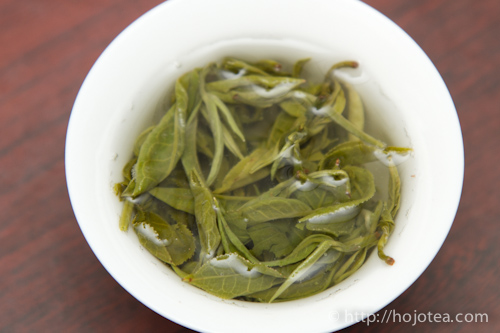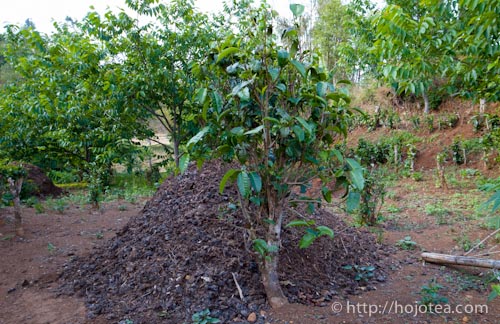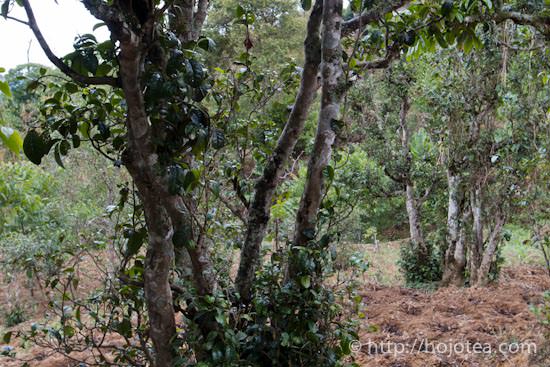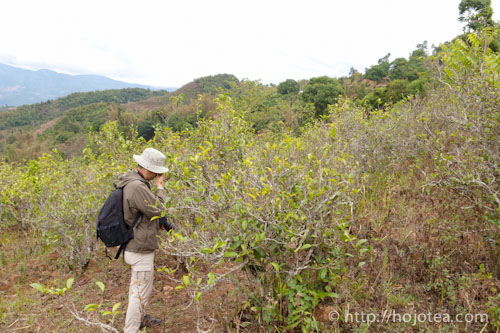- HOME >
- How to choose quality tea
Tips on Tea Quality Inspection
- [2013.03.21] Posted By Akira Hojo
There are many ways to judge the quality of tea. Among all, I would like to introduce one method: to check the unrolling speed of brewed leaf. The high quality leaf unroll very fast, while the poor quality leaf takes a long time to unroll, or sometimes it does not perfectly unroll. I would like to explain why this phenomenon occurs.
Nitrogen boost the growing speed of tea
Regardless of tea or other agricultural plants like fruit and vegetable, the plants must grow slowly in order to produce thick, smooth and strong after taste. The natural plant does not grow as fast as the artificial plant. If you look at the natural plant, you may notice that the colour of leaves is not very green; it’s yellowish. If nitrogen-based fertilizer is added, plant grows quickly. When plant grows faster, it forms more cell walls and the cells become bigger. It also forms other necessary constituents, e.g., the quantity of chlorophylls increase and leaf becomes green in colour. When leaf grows excessively, the tea leaf becomes bigger size not because it increases the number of cell, but the size of cell. Eventually, tea leaf contains very less constituents, and the tea processed from the big leaf tastes very light and flat.
My father used to tell me about the same story regarding his apple. He said that there were a number of farmers who applied a lot of fertilizers in order to make the apple grow bigger and increase the output. In fact, it is very easy to tell if apple is grown with a lot of fertilizers. Its taste becomes very thin, watery and less body.
On the contrary, the tea grown under the harsh environment without fertilizer or pesticide produces very small leaf; leaf is thick, elastic and yellow in colour. Despite tea leaf is so small, it consists of a huge number of tiny cells.
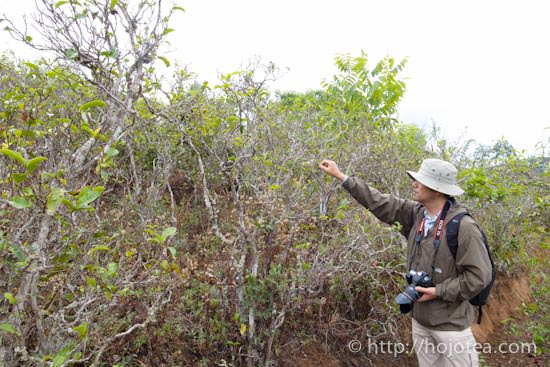
The garden managed follow the natural farming method
The dark green and large leaf
One of the processing steps of tea is rolling. After the rolling process, there is a noticeable difference between large-dark green leaf and small-yellow leaf. The large leaves are easily cracked as each cell is too big. If the cells are so big, it is mechanically weak. It is just like a building with pillars that are too long.
On the contrary, the naturally grown leaf is very elastic and strong as it consists of a huge number of tiny cells. The cells of small leaf never get cracked no matter how much it is rolled. In fact, big tea leaf is very weak even when it is fresh; it easily cracked when I rolled it on my palm. As for the yellow and small leaf, it is very elastic and strong. I can hardly crack it and it’s like a rubber.
Besides, the elasticity of tea leaf is related to the amount of dust generated during tea processing. If tea leaf has a huge number of tiny cells, it generates very less dust during processing. Most of the tea leaves remain intact due to its elasticity.
You can see many broken leaf. (The one on the right is the last year crop. So please ignore that the colour of leaf is slightly more yellowish)
You can see that for the leaf on the right, there is no broken leaf, thick and looks so elastic; its quality is much better than the tea on the left.
The cell wall of poor tea is cracked during rolling process. When it is brewed, it does not unrolled swiftly since it is cracked. It takes a long time to unroll or sometimes it doesn’t fully unroll even after several brewing. The cracked leaf cannot reverse just like it is no use crying over spilt milk. As for high quality leaf, once the hot water is poured onto the leaf, it unrolls briskly to its original leaf shape. This is one of the important indexes to observe the quality tea.
The only exceptional is the heavily-roasted tea. Regardless of high or low quality tea, the leaf takes a longer time to unroll as it has been deeply-heated during baking.
Related Articles
How to get the latest update on HOJO Tea?
1. Follow Twitter, 2. Click "Like" on Facebook, and 3. Subscribe in newsletter. You can have the latest tea news from HOJO Tea.
 Subscribe the Newsletter to enjoy the privileges
Subscribe the Newsletter to enjoy the privileges- You may receive a free sample upon purchase, or you may have the priority to purchase special products. So please remember to subscribe our newsletter as well as the social network.
- New Release of High Mountain White Tea
- We are pleased to introduce our High Mountain White Tea, sourced from a unique tea garden with two key features: 1. Located at an altitude of 2200-2300m2. Completely wild and untended The ideal natural conditions of this garden result in tea of exceptional quality, offering a pure and gentle, nourishing taste. High Altitude and Wild …
- New Release of Da Xue Shan Wild White Tea 2024
- We have released the 2024 Da Xue Shan Wild White Tea Loose Leaf. This tea was produced under our direct supervision during our stay in Yunnan Province, ensuring meticulous production management on site. Definition of Wild Tea in Yunnan Province People in Yunnan strongly associate Camellia taliensis with wild tea, regardless of where it is …
NEW ARTICLES
 Why Do Some Teas Taste Astringent? Exploring the Causes and Mechanisms of Astringency
Why Do Some Teas Taste Astringent? Exploring the Causes and Mechanisms of Astringency- Tea can range from having no noticeable astringency to possessing a very strong one. What causes this astringency? This article explores the causes and mechanisms behind astringency in tea. Causes of Astringency Astringency arises from the binding of tea components to proteins in the oral cavity, creating a sensation of tightness or dryness. The tongue …
 The Impact of Heat Sources on Tea Flavor
The Impact of Heat Sources on Tea Flavor- It is widely recognized that the material of a kettle plays an important role in shaping the taste of water for brewing tea. Yet, an often overlooked but equally significant factor is the type of heat source used to boil the water. Different heat sources, whether gas, electric, charcoal, or wood fire, can impart distinct …
 New Release of High Mountain White Tea
New Release of High Mountain White Tea- We are pleased to introduce our High Mountain White Tea, sourced from a unique tea garden with two key features: 1. Located at an altitude of 2200-2300m2. Completely wild and untended The ideal natural conditions of this garden result in tea of exceptional quality, offering a pure and gentle, nourishing taste. High Altitude and Wild …
 New Release of Da Xue Shan Wild White Tea 2024
New Release of Da Xue Shan Wild White Tea 2024- We have released the 2024 Da Xue Shan Wild White Tea Loose Leaf. This tea was produced under our direct supervision during our stay in Yunnan Province, ensuring meticulous production management on site. Definition of Wild Tea in Yunnan Province People in Yunnan strongly associate Camellia taliensis with wild tea, regardless of where it is …
 New Release of Wild Pu-erh Jasmine Pearl
New Release of Wild Pu-erh Jasmine Pearl- Out of curiosity, we decided to create a jasmine tea based on Da Xue Shan Wild Raw Tea. This resulted in an exceptionally rare tea, not only in Japan but also in China. Custom Production Network for Jasmine Tea At our store, we source various types of base teas from different regions during the spring. …
 2024 Overview: Our Yunnan White Tea Quality, Process, and Weather Insights
2024 Overview: Our Yunnan White Tea Quality, Process, and Weather Insights- One of the teas we’ve been focusing on in Yunnan Province is white tea. Historically white tea has been produced in both Fujian Province and Yunnan Province for a long time. While white tea from Fujian Province is well-managed during processing, we are dissatisfied with the quality of the raw materials due to the use …
 Yunnan’s Hospitality Culture: Expressed Through Meals
Yunnan’s Hospitality Culture: Expressed Through Meals- In China, as a form of greeting, it’s common to say “你吃饭了吗?” which means “Have you eaten?” However, in Yunnan Province, the phrase “吃饭” is often used in various situations, more like “Eat, eat,” serving as an invitation to share a meal. Yet, with prolonged exposure to Yunnan, one comes to understand that these meal …
 In Search of Wild Tea: Exploring Mountain Villages in Southwest Lincang, Yunnan
In Search of Wild Tea: Exploring Mountain Villages in Southwest Lincang, Yunnan- We are currently sourcing tea in the southwestern part of Lincang City, Yunnan Province. One of the crucial products for us is wild tea. While tea processing is important, securing the raw materials poses the biggest challenge. Recently, we received information about a new location where wild tea supposedly grows. To verify this, we visited …
 New Release of Anxi Traditional Oolong
New Release of Anxi Traditional Oolong- Anxi, located in Fujian province, China, is celebrated for its Tie Guan Yin tea. However, the Traditional Anxi Oolong from this region boasts a unique fruity aroma, distinguishing it from Tie Guan Yin. Anxi: A Renowned Hub for Oolong Tea Production in China Fujian Province, renowned for its rich tea heritage, boasts several prominent tea-producing …
 Yunnan 2024 Spring Tea Sourcing
Yunnan 2024 Spring Tea Sourcing- Yunnan Province is globally renowned for the exceptional quality of its tea leaves. However, lax production management often presents challenges in achieving the desired tea quality when relying solely on pre-made teas. To address this issue, we have committed to remaining on-site throughout the spring season to closely monitor tea production. We are meticulously inspecting …
Shop Info

Address:Lot No. T-215, 3rd Floor, The Gardens Mall, Mid Valley City, Lingkaran Syed Putra, 59200 Kuala Lumpur
Tel: +603-2287-4537
Business Hour: 10am to 10pm
Category
- New Arrival at HOJO Online Shop
- Featured Articles
- Newsletter
- Types of Tea
- Origin of Tea
- Teapot and Tea Equipment
- Tea Column
- How to enjoy tea
- Tea Processing
- How to choose quality tea
- Tea constituents and functional effect
- Safety of Tea
- Foods
- Tea Business Operation
- Hobby and Outdoor Activity
- Ranking of Tea
- Video
- FAQ
- Media Release
Profile

- AKIRA HOJO
- I invite you to experience my tea selections.I was born in Nagano, Japan. In university, I studied agricultural chemistry, and I have the master degree in food science. I worked in Japanese food industry for 10 years. I involved in R&D, QC and QA. As a factory manager, I implemented ISO9000 series and managed the factory.
- The Art of Tea Magazine
- We posted the article on “The Art of Tea Magazine No.9, the magazine is published in Taiwan. We featured some scientific view about the tetsubin
- New Straits Times
- The Malaysian National Newspaper, New Straits Times featured HOJO Tea on 17-Oct-2007.

